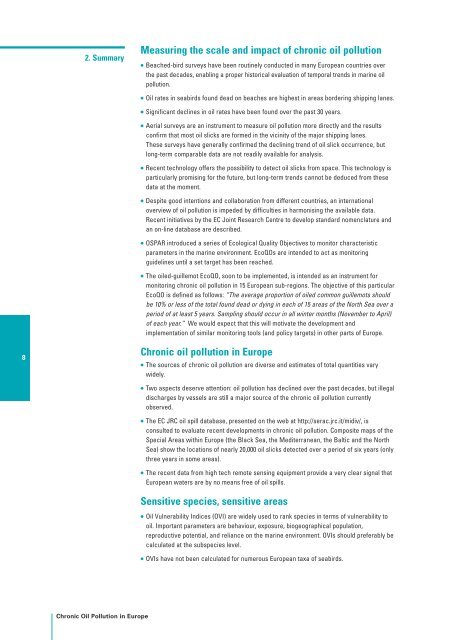Chronic oil pollution in Europe - International Fund for Animal Welfare
Chronic oil pollution in Europe - International Fund for Animal Welfare
Chronic oil pollution in Europe - International Fund for Animal Welfare
You also want an ePaper? Increase the reach of your titles
YUMPU automatically turns print PDFs into web optimized ePapers that Google loves.
8<br />
2. Summary<br />
<strong>Chronic</strong> Oil Pollution <strong>in</strong> <strong>Europe</strong><br />
Measur<strong>in</strong>g the scale and impact of chronic <strong>oil</strong> <strong>pollution</strong><br />
• Beached-bird surveys have been rout<strong>in</strong>ely conducted <strong>in</strong> many <strong>Europe</strong>an countries over<br />
the past decades, enabl<strong>in</strong>g a proper historical evaluation of temporal trends <strong>in</strong> mar<strong>in</strong>e <strong>oil</strong><br />
<strong>pollution</strong>.<br />
• Oil rates <strong>in</strong> seabirds found dead on beaches are highest <strong>in</strong> areas border<strong>in</strong>g shipp<strong>in</strong>g lanes.<br />
• Significant decl<strong>in</strong>es <strong>in</strong> <strong>oil</strong> rates have been found over the past 30 years.<br />
• Aerial surveys are an <strong>in</strong>strument to measure <strong>oil</strong> <strong>pollution</strong> more directly and the results<br />
confirm that most <strong>oil</strong> slicks are <strong>for</strong>med <strong>in</strong> the vic<strong>in</strong>ity of the major shipp<strong>in</strong>g lanes.<br />
These surveys have generally confirmed the decl<strong>in</strong><strong>in</strong>g trend of <strong>oil</strong> slick occurrence, but<br />
long-term comparable data are not readily available <strong>for</strong> analysis.<br />
• Recent technology offers the possibility to detect <strong>oil</strong> slicks from space. This technology is<br />
particularly promis<strong>in</strong>g <strong>for</strong> the future, but long-term trends cannot be deduced from these<br />
data at the moment.<br />
• Despite good <strong>in</strong>tentions and collaboration from different countries, an <strong>in</strong>ternational<br />
overview of <strong>oil</strong> <strong>pollution</strong> is impeded by difficulties <strong>in</strong> harmonis<strong>in</strong>g the available data.<br />
Recent <strong>in</strong>itiatives by the EC Jo<strong>in</strong>t Research Centre to develop standard nomenclature and<br />
an on-l<strong>in</strong>e database are described.<br />
• OSPAR <strong>in</strong>troduced a series of Ecological Quality Objectives to monitor characteristic<br />
parameters <strong>in</strong> the mar<strong>in</strong>e environment. EcoQOs are <strong>in</strong>tended to act as monitor<strong>in</strong>g<br />
guidel<strong>in</strong>es until a set target has been reached.<br />
• The <strong>oil</strong>ed-guillemot EcoQO, soon to be implemented, is <strong>in</strong>tended as an <strong>in</strong>strument <strong>for</strong><br />
monitor<strong>in</strong>g chronic <strong>oil</strong> <strong>pollution</strong> <strong>in</strong> 15 <strong>Europe</strong>an sub-regions. The objective of this particular<br />
EcoQO is def<strong>in</strong>ed as follows: “The average proportion of <strong>oil</strong>ed common guillemots should<br />
be 10% or less of the total found dead or dy<strong>in</strong>g <strong>in</strong> each of 15 areas of the North Sea over a<br />
period of at least 5 years. Sampl<strong>in</strong>g should occur <strong>in</strong> all w<strong>in</strong>ter months (November to April)<br />
of each year.” We would expect that this will motivate the development and<br />
implementation of similar monitor<strong>in</strong>g tools (and policy targets) <strong>in</strong> other parts of <strong>Europe</strong>.<br />
<strong>Chronic</strong> <strong>oil</strong> <strong>pollution</strong> <strong>in</strong> <strong>Europe</strong><br />
• The sources of chronic <strong>oil</strong> <strong>pollution</strong> are diverse and estimates of total quantities vary<br />
widely.<br />
• Two aspects deserve attention: <strong>oil</strong> <strong>pollution</strong> has decl<strong>in</strong>ed over the past decades, but illegal<br />
discharges by vessels are still a major source of the chronic <strong>oil</strong> <strong>pollution</strong> currently<br />
observed.<br />
• The EC JRC <strong>oil</strong> spill database, presented on the web at http://serac.jrc.it/midiv/, is<br />
consulted to evaluate recent developments <strong>in</strong> chronic <strong>oil</strong> <strong>pollution</strong>. Composite maps of the<br />
Special Areas with<strong>in</strong> <strong>Europe</strong> (the Black Sea, the Mediterranean, the Baltic and the North<br />
Sea) show the locations of nearly 20,000 <strong>oil</strong> slicks detected over a period of six years (only<br />
three years <strong>in</strong> some areas).<br />
• The recent data from high tech remote sens<strong>in</strong>g equipment provide a very clear signal that<br />
<strong>Europe</strong>an waters are by no means free of <strong>oil</strong> spills.<br />
Sensitive species, sensitive areas<br />
• Oil Vulnerability Indices (OVI) are widely used to rank species <strong>in</strong> terms of vulnerability to<br />
<strong>oil</strong>. Important parameters are behaviour, exposure, biogeographical population,<br />
reproductive potential, and reliance on the mar<strong>in</strong>e environment. OVIs should preferably be<br />
calculated at the subspecies level.<br />
• OVIs have not been calculated <strong>for</strong> numerous <strong>Europe</strong>an taxa of seabirds.

















